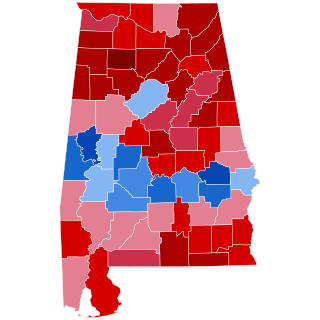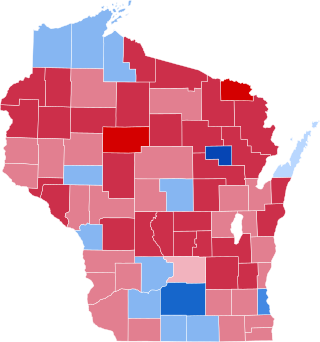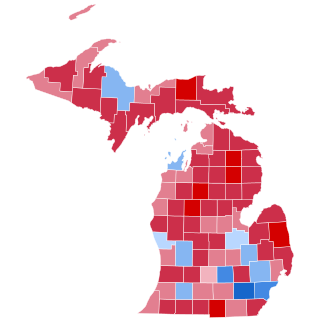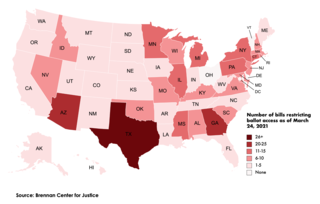In American politics, a blue shift, also called a red mirage, [1] [2] is an observed phenomenon under which counts of in-person votes are more likely than overall vote counts to be for the Republican Party (whose party color is red), while provisional votes or absentee ballots, which are often counted later, are more likely than overall vote counts to be for the Democratic Party (whose color is blue). [3] [4] This means that election day results can initially indicate a Republican is ahead, but adding provisional ballots and absentee ballots into the count can eventually show a Democratic victory.
Confusion about the blue shift phenomenon has led some Republicans to call the legitimacy of elections into question when, in fact, the election results were legitimate. [5] [6] Blue shift occurs because young voters, low-income voters, and voters who relocate often are likely both to vote provisionally and to lean Democratic. [7] This phenomenon remains poorly understood by the general public and election experts, and can cause confusion given that Americans are accustomed to learning projected results on election day and often assume the projected results announced then are an accurate representation of final results. [8]
The phenomenon was first identified by Edward Foley of Ohio State University in 2013. [7] He found that Democratic candidates are significantly more likely to gain votes during the "canvass" period, which is the votes counted after election night. [9] This asymmetry has not always existed; in the 20th century, as recently as the 1996 United States presidential election, Republicans and Democrats were both able to cut their opponents' leads during the canvass period. Foley conjectured that the 2002 enactment of the Help America Vote Act accelerated the pronounced asymmetry of the blue shift phenomenon, because it required states to allow provisional ballots to be cast. [9] He later found that the variation in the size of the blue shift is positively associated with the number of provisional ballots and the Democratic partisanship of the state in question. [10] The growth in the persistent blue-shifted overtime vote began with the 2004 United States presidential election. [11] However, Foley has stated that political scientists have not fully "pinned down causality" of this phenomenon. [8] Foley did not find that mail-in or absentee votes favored either party. [8]
As results are tabulated on election night, smaller and more rural jurisdictions have fewer ballots to tabulate, so can complete reporting faster. Thus, early results often lean conservative as larger counties take their time to process ballots. [12] One notable instance of this occurring was the 2010 California Attorney General election. Republican Steve Cooley was up by several points with Los Angeles and Alameda counties, two of the state's largest, scheduled to report most of their ballots around midnight. In order to meet evening newscasts, Cooley declared victory at 11 pm, but continuing results from the urban counties led to the race being declared too close to call by most media outlets, and Cooley ultimately losing to Democrat Kamala Harris by 0.7 percentage points. [13] [14]
States vary in their rules for processing mail-in ballots. While some require they be received by the elections office by election day, others allow them to arrive later and still be counted, provided they are postmarked by election day. Some states allow ballots to be processed as they are delivered, while some force elections offices to wait until election day to verify signatures and open envelopes. These factors can influence the difference between the vote that is announced on election night and that counted later. [15]
One example is the 2018 California's 39th congressional district election. This was a hotly contested race for an open seat in the United States House of Representatives that included portions of Orange, Los Angeles, and San Bernardino counties in Southern California. Republican Young Kim was running against Democrat Gil Cisneros. On election night, November 6, Kim held a lead of 3 percentage points and over 15,000 votes over Cisneros. However, as the votes were counted over the ensuing weeks, Cisneros overtook Kim in the vote count, and won the election. [3] A blue shift occurred in other California races as well –Republican House incumbents Jeff Denham, Mimi Walters and David Valadao were all leading on election night, but ended up losing as mail-in ballots skewed heavily in favor of their Democratic challengers. [16]
Another notable example of blue shift was the 2018 United States Senate election in Arizona between Republican Martha McSally and Democrat Kyrsten Sinema. McSally led the vote count on election night, but Sinema ultimately won the election due to mail-in ballots. [17] Democrats initially thought that they had lost that election, when they had actually won. [18] In addition to these examples, blue shift has been documented in California, [3] Pennsylvania, [7] Oregon, and Ohio, [9] among other states.
Foley expressed concern that this phenomenon, along with difficulties in conducting the election during a pandemic, could lead to "a perfect storm" in the 2020 United States presidential election. [19] The blue shift could decide the election. [8] This concern was particularly pronounced due to the fact that incumbent president Donald Trump did not state before the election whether he would accept election results. [20] Given Trump's repeated attacks on mail balloting, nonpartisan experts warned that he might plan to build up a lead among ballots cast on Election Day, claim victory, and then say, "stop counting ballots because all those absentee ballots are illegitimate", thus disallowing the likely blue shift. [21]
In addition, the United States Postal Service had cost-cutting policies put in place by its new director Louis DeJoy, who was a top donor and fundraiser to Donald Trump, and these cost-cutting policies further slowed delivery of postal ballots. Trump had openly stated that he opposed USPS funding, specifically to prevent mail-in ballots, due to his fears that it could hurt his chances of re-election. [22] These changes have become known as the 2020 United States Postal Service crisis. Some accused Trump of "intentionally kneecapping the postal service in an attempt to sabotage the election." [23] These concerns were echoed by former president Barack Obama, who described Trump's threats as "unheard of". [24] For this reason, election experts advocated that postal ballots be mailed weeks in advance of Election Day. [25] As an alternative solution, Jamelle Bouie of The New York Times advocated that Democrats vote in person if they were able. [26]
U.S. data and analytics company Hawkfish predicted that on election night in 2020, U.S. Republican party nominee and presidential incumbent Donald Trump would receive more in-person votes than Joe Biden, his Democratic party nominee and principal challenger, but when absentee, provisional, and mail-in ballots were counted, the election would swing against Trump in a classic "red mirage" or "blue shift" scenario. [1] [27] Hawkfish's survey asked 17,263 American voters whether they planned to use absentee ballots or go to the polls. [27] Asked about the scenario, Trump campaign communications director Tim Murtaugh told reporters, "The news media should get out of the business of predicting the future." [28]
Within hours after the earliest poll closings on the evening of November 3, 2020, Trump claimed victory in several states that had Trump leading, but in which his margins were shrinking as mail-in ballots were counted. [29] At 2:30 a.m. EST on Wednesday, speaking to supporters, he said, "We want all voting to stop." [29] At the time he had a lead in Michigan of 300,000 votes and in Pennsylvania of 690,000 votes. [29] Wisconsin was also seeing a red mirage, but the state was called for Biden at 4:40 a.m. after a ballot dump of 69,000 absentee ballots turned Trump's 31,000-vote lead into a narrow lead for Biden that would be impossible for the outstanding vote total to surpass. [30] [31] By 8:30 a.m., with counting of absentee ballots begun, Trump's lead in Pennsylvania had shrunk to 610,000 and in Michigan, Biden had pulled ahead and it was called for him at 5:56 p.m. EST. [29] [32] At 11:25 a.m. EST on November 7, four days after Election Night, ABC News, NBC News, CBS News, the Associated Press, CNN and Fox News all called the election for Biden based on his large lead in Pennsylvania and the fact that the outstanding vote total, mostly from heavily Democratic areas, would be nearly impossible for Trump to overcome. [33] [34]
There are differing reports in other countries as to whether mail-in or early ballots have a notably different political makeup than election day in person votes. In Germany, mail-in voters tend to be more urban than in person voters, tend to be more certain about their voting decisions, and favor bigger parties. [35] A "shift" does not usually feature in news coverage as both in-person and mail-in votes are counted beginning at 18:00 when polling booths close. Mail-in votes that arrive later than 18:00 on election day are discarded [36] –even if they only arrived late due to circumstances outside of the control of voters. [37] However, given that exit polls are based only on in-person voters, the first prognosis of the election result, which is released immediately after polls close, often differs from the final result among other reasons due to the effect of mail-in ballots. The 2020 Bavarian local elections had their runoff election held as all mail-in (due to the COVID-19 pandemic) and some observers discounted that it had any partisan effect. [38] Germany has seen an increase of mail-in voting at federal elections since their introduction in 1957 from less than one in twenty in 1957 to more than one in four in 2017. [39] In the May round of the 2016 Austrian presidential election, exit polls correctly pointed to a narrow lead for Norbert Hofer among those who voted at a polling station. [40] The postal votes, which made up about 12% of the total vote, [41] were slightly but definitively in favour of his rival Alexander Van der Bellen, and ultimately gave Van der Bellen victory.

The 2020 United States presidential election was the 59th quadrennial presidential election, held on Tuesday, November 3, 2020. The Democratic ticket of former vice president Joe Biden and the junior U.S. senator from California Kamala Harris defeated the incumbent Republican president, Donald Trump, and vice president, Mike Pence. The election took place against the backdrop of the global COVID-19 pandemic and related recession. The election saw the highest voter turnout by percentage since 1900, with each of the two main tickets receiving more than 74 million votes, surpassing Barack Obama's record of 69.5 million votes from 2008. Biden received more than 81 million votes, the most votes ever cast for a candidate in a U.S. presidential election.

Bradford Jay Raffensperger is an American businessman, civil engineer, and politician serving as the Secretary of State of Georgia since 2019. A member of the Republican Party, he previously served in the Georgia House of Representatives, representing District 50.

The 2020 United States presidential election in Alabama took place on Tuesday, November 3, 2020, as part of the 2020 United States presidential election in which all 50 states and the District of Columbia participated. Alabama voters chose nine electors to represent them in the Electoral College via a popular vote pitting incumbent Republican President Donald Trump and his running mate, incumbent Vice President Mike Pence, against Democratic challenger and former Vice President Joe Biden and his running mate, United States Senator Kamala Harris of California. Also on the ballot was the Libertarian nominee, psychology lecturer Jo Jorgensen and her running mate, entrepreneur and podcaster Spike Cohen. Write-in candidates were permitted without registration, and their results were not individually counted.

The 2020 United States presidential election in Alaska took place on Tuesday, November 3, 2020, as part of the 2020 United States presidential election in which all 50 states and the District of Columbia participated. Alaska voters chose three electors to represent them in the Electoral College via a popular vote pitting incumbent Republican President Donald Trump and his running mate, incumbent Vice President Mike Pence, against Democratic challenger and former Vice President Joe Biden and his running mate, United States Senator Kamala Harris of California. The Libertarian, Green, Constitution, and Alliance Party nominees were also on the ballot, as was an Independent candidate.

The 2020 United States presidential election in Arizona was held on Tuesday, November 3, 2020, as part of the 2020 United States presidential election, in which all 50 states and the District of Columbia participated. Arizona voters chose 11 electors to represent them in the Electoral College via a popular vote pitting incumbent Republican President Donald Trump of Florida and his running mate, incumbent Vice President Mike Pence of Indiana, against Democratic challenger and former Vice President Joe Biden of Delaware and his running mate, United States Senator Kamala Harris of California. The Libertarian nominees were also on the ballot.

The 2020 United States presidential election in Georgia was held on Tuesday, November 3, 2020, as part of the 2020 United States presidential election in which all 50 states plus the District of Columbia participated. Georgia voters chose electors to represent them in the Electoral College via a popular vote, pitting the Republican Party's nominee, incumbent President Donald Trump of Florida, and running mate Vice President Mike Pence of Indiana against Democratic Party nominee, former Vice President Joe Biden of Delaware, and his running mate Senator Kamala Harris of California. Georgia has 16 electoral votes in the Electoral College.

The 2020 United States presidential election in Pennsylvania was held on Tuesday, November 3, 2020, as part of the 2020 United States presidential election in which all 50 states plus the District of Columbia participated. Pennsylvania voters chose electors to represent them in the Electoral College via a popular vote, pitting the Republican Party's nominee, President Donald Trump, and running mate Vice President Mike Pence against Democratic Party nominee, former Vice President Joe Biden, and his running mate California Senator Kamala Harris. Pennsylvania has 20 electoral votes in the Electoral College.

The 2020 United States presidential election in Texas was held on Tuesday, November 3, 2020, as part of the 2020 United States presidential election in which all 50 states plus the District of Columbia participated. Texan voters chose 38 electors to represent them in the Electoral College. In a popular vote the Republican Party's nominee, incumbent President Donald Trump, and running mate Vice President Mike Pence won all the electors against the Democratic Party's nominee, former Vice President Joe Biden, and his running mate California Senator Kamala Harris.

The 2020 United States presidential election in New York was held on Tuesday, November 3, 2020, as part of the 2020 United States presidential election in which all 50 states plus the District of Columbia participated. New York voters chose electors to represent them in the Electoral College via a popular vote, pitting the Republican Party's nominee, incumbent President Donald Trump, and running mate Vice President Mike Pence against Democratic Party nominee, former Vice President Joe Biden, and his running mate California Senator Kamala Harris. New York had 29 electoral votes in the Electoral College. Trump announced that Florida would be his home state for this election, rather than New York as it had been previously. This was the first presidential election in New York to allow no-excuse absentee voting.

The 2020 United States presidential election in Wisconsin was held on Tuesday, November 3, 2020, as part of the 2020 United States presidential election in which all 50 states plus the District of Columbia participated. Wisconsin voters chose electors to represent them in the Electoral College via a popular vote, pitting the Republican Party's nominee, incumbent President Donald Trump, and running mate Vice President Mike Pence against Democratic Party nominee, former Vice President Joe Biden, and his running mate California Senator Kamala Harris. Wisconsin has 10 electoral votes in the Electoral College.

The 2020 United States presidential election in Michigan was held on Tuesday, November 3, 2020, as part of the 2020 United States presidential election in which all 50 states plus the District of Columbia participated. Michigan voters chose electors to represent them in the Electoral College via a popular vote, pitting the Republican Party's nominee, incumbent President Donald Trump of Florida, and his running mate, Vice President Mike Pence of Indiana against the Democratic Party nominee, former Vice President Joe Biden of Delaware, and his running mate, Senator Kamala Harris of California. Michigan had 16 electoral votes in the Electoral College.

Postal voting in the United States, also referred to as mail-in voting or vote by mail, is a form of absentee ballot in the United States, in which a ballot is mailed to the home of a registered voter, who fills it out and returns it by postal mail or drops it off in-person at a secure drop box or voting center. Postal voting reduces staff requirements at polling centers during an election. All-mail elections can save money, while a mix of voting options can cost more. In some states, ballots may be sent by the Postal Service without prepayment of postage.
Transition Integrity Project (TIP) was a series of political scenario exercises in the United States at the beginning of June 2020, involving over 100 current and former senior government and campaign leaders, academics, journalists, polling experts and former federal and state government officials. The exercises examined potential disruptions to the 2020 presidential election and transition. TIP is not an organization, but rather a short-term project run under the auspices of the organization Protect Democracy.
Edward B. Foley is an American lawyer, law professor, election law scholar, and former Ohio Solicitor General. He is the theorist of the blue shift, a phenomenon in American politics in which in-person votes overstate overall percentage of votes for the Republican Party, while provisional votes, which are counted after election day, tend to overstate overall percentage of votes for the Democratic Party. When the provisional votes are counted after the election, there is often a shift in totals toward the Democrat, or blue, candidate.

Postal voting played an important role in the 2020 United States elections, with many voters reluctant to vote in person during the ongoing COVID-19 pandemic. The election was won by Joe Biden, the Democratic candidate. The Republican candidate President Donald Trump made numerous false claims of widespread fraud arising from postal voting, despite nearly-universal agreement to the contrary, with overwhelming amounts of supporting evidence, by the mainstream media, fact-checkers, election officials, and the courts.
The following is a timeline of major events before, during, and after the 2020 United States presidential election, the 59th quadrennial United States presidential election, from November 2020 to January 2021. For prior events, see Timeline of the 2020 United States presidential election (2017–2019) and Timeline of the 2020 United States presidential election.
In direct response to Pennsylvania Democratic Party v. Boockvar and the 2020 United States presidential election in Pennsylvania, the Donald Trump 2020 presidential campaign launched numerous lawsuits contesting the purview of the Pennsylvania Supreme Court and the election processes of Pennsylvania. All of these have either been dismissed or dropped. The last two remaining cases were dismissed without comment by the Supreme Court on February 22, 2021. On April 19, 2021, more than five months after the November 3, 2020 election, the Supreme Court declined to hear the outstanding case brought by former Republican congressional candidate Jim Bognet, dismissing it without comment.
The following is a timeline of major events leading up and during the 2020 United States presidential election, the 59th quadrennial United States presidential election, from January to October 2020. For previous events, see Timeline of the 2020 United States presidential election (2017–2019). For subsequent events, see Timeline of the 2020 United States presidential election

Following the 2020 United States presidential election and the unsuccessful attempts by Donald Trump and various other Republican officials to overturn it, Republican lawmakers initiated a sweeping effort to make voting laws more restrictive within several states across the country. According to the Brennan Center for Justice, as of October 4, 2021, more than 425 bills that would restrict voting access have been introduced in 49 states—with 33 of these bills enacted across 19 states so far. The bills are largely centered around limiting mail-in voting, strengthening voter ID laws, shortening early voting, eliminating automatic and same-day voter registration, curbing the use of ballot drop boxes, and allowing for increased purging of voter rolls. Republicans in at least eight states have also introduced bills that would give lawmakers greater power over election administration after they were unsuccessful in their attempts to overturn election results in swing states won by Democratic candidate Joe Biden in the 2020 election. The efforts garnered press attention and public outrage from Democrats, and by 2023 Republicans had adopted a more "under the radar" approach to achieve their goals.

The 2020 election in New York's 22nd congressional district was part of the 2020 United States House of Representatives elections in the state. The major-party candidates were Democratic incumbent Anthony Brindisi and Republican Claudia Tenney, with a third-party candidate, Libertarian Keith Price, also participating. In the 2018 House race in this district, Brindisi unseated the freshman incumbent Tenney by a margin of less than 1 percent. The rematch was expected to be just as competitive.
As Trump prepared for Election Day, he was focused on the so-called red mirage. This was the idea that early vote counts would look better for Republicans than the final tallies because Democrats feared COVID-19 more and would disproportionately cast absentee votes that would take longer to count.
{{cite web}}: CS1 maint: multiple names: authors list (link)